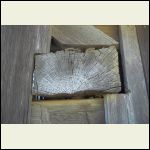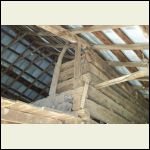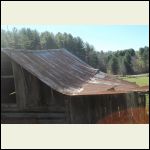|
| Author |
Message |
bnichols1961
Member
|
# Posted: 15 Apr 2016 08:50am
Reply
So i have a few options but hopefully someone has better ideas or solutiions- The are of concern is securing the logs together, I can use tappered Wooden Dowels-Very Time Consuming, I can use rebar by drillig a hole first then driving rebar which takes a lot of Driving Power to set the Rebar, Or I can use the 12 inch long Log Screws which is Expensive ($190.00 for 250 Screws)
any other suggestions or ideas please fell free
|
|
toyota_mdt_tech
Member
|
# Posted: 15 Apr 2016 10:36am
Reply
Can you pin it with rebar and drill oversized holed to it floats for the shrinkage etc? What type of corners you using, saddle, butt/pass?
|
|
bnichols1961
Member
|
# Posted: 15 Apr 2016 10:39am
Reply
BUTT/PASS METHOD
was thinking drilling hole same size or slightly smaller and as the Tree shrinks it should tighten up
Does that make sense
|
|
Wilbour
Member
|
# Posted: 15 Apr 2016 11:36am
Reply
My neighbour's 10 x 10 cabin is held together with springs... honestly. Now I have noticed it leans to one side thanks to the prevailing winds....honestly 
|
|
bnichols1961
Member
|
# Posted: 15 Apr 2016 11:37am
Reply
SPRINGS???
|
|
bldginsp
Member
|
# Posted: 15 Apr 2016 01:45pm
Reply
Bungee cords
|
|
Don_P
Member
|
# Posted: 15 Apr 2016 10:37pm
Reply
The two spring methods I know of use either lags with a spring under the washer in a countersunk hole, or, full height allthread running from under floor to top plate with a large washer and spring. Neither of these would really cause a wall to lean but I have doubts as to how much they really do, some folks swear by them though.
The olys work well, count on one every 24-32" in every row, I like to have some log hogs and lag screws handy as well for logs that don't want to sit down.
I guess the worst case we ran into, there was one kit log home we were called in on. The owner builder realized he had gotten in to more than he had time for and the package had been on the ground for a year. The Virginia pine logs had moved since milling and we were having fun getting things to fit. At one point I was working on something else and my wife had a twisted log she had run 5 lag bolts into and was working them down 1/4 turn each at a time. An oly will not break but will spin out without pulling a pesky log down. A typical 3/8x10 lag has much more pull. I heard a tommy gun go off. All 5 lags broke in an instant.
|
|
bldginsp
Member
|
# Posted: 15 Apr 2016 11:49pm
Reply
They make spring loaded self tightening nuts for use in wood frame buildings to tighten bolts after the walls are closed and the wood continues to shrink and settle. No idea if these have been used in log building.
|
|
|
toyota_mdt_tech
Member
|
# Posted: 16 Apr 2016 10:09am
Reply
The LHBA use the butt pass method and pin them all with rebar. I would make a snug fit and how many, not certain, but I'd use enough. The weight of the walls should compress itself as it dries out.
|
|
leonk
Member
|
# Posted: 16 Apr 2016 08:09pm
Reply
I hate metal parts in log cabin, some people say it causes decay too if you're in freezing climate.
If you have a good size drill and can find dowels, it's not a big deal to install them, no need to taper.
Another option is long 'nails' as used in landscaping, if the wood is dry they will require drilling holes, to avoid splitting.
|
|
Don_P
Member
|
# Posted: 16 Apr 2016 09:07pm
Reply
Not a great pic, this was a log springhouse door, half dovetail corners. This door buck was pegged to the end grain of each log as it butted against the door buck. Just roughly drawknifed. The window and door bucks are the only connections in those old ones. Those log buildings tend to drop in the stacked corners but cannot where there are tight bucks so many tend to droop at the corners over time.
These were often built without rafter ties as well. The top plate log was sometimes pegged down on the ends but either way they often experienced plate roll where the spreading bottoms of the untied rafters toggled against the top log and rolls it out.
One log barn I wandered through had a square hewn top plate log set diamond orientation into V's notched into the gable end logs. The roof is 12/12, 45 degrees, the rafters are lightly notched into the top of the plate with most of their depth passing over undiminished to form the tails. The plate cannot roll the rafters are simple and yet work well, the builder was sharp.
The weight of the walls and roof, even under load is insufficient to do as much compressing as most folks think. It doesn't take much to stop settlement, the nails in the trim can hold up the house. Installing connectors at divergent angles, two spikes or any connector at anything other than plumb and in line with one another and things don't slide easily or at all, things still shrink, and twist, hanging the hole up on the connector, but don't necessarily settle. This isn't necessarily a bad thing either if its a chinker. I believe the rebar pinned B&P buildings are more along those lines.
|
|
Don_P
Member
|
# Posted: 17 Apr 2016 12:36pm
Reply
I went out with an engineer friend this morning to survey an old log structure at the local farm museum, thought y'all might enjoy a few of the pics.
first shot is the top plate log pegged to the gable course below to prevent it sliding or rolling under rafter thrust. These appear to be 2" pegs bored with a mortising machine. Of the 4 corners, this was the only one intact. The rafter is also pegged to the plate. Seriously undersized rafters!
pic 2, lots going on here. This plate peg and the log end were decayed. Notice the plate log is shifted out and close to ready to fall. The front shed carry beam is broken and propped, the log ends across the upper gable have been cut out for barn use and a vertical 1x6 nailed on to stabilize them and prop the roof, this could not settle, popped the tin open and admitted water, destroying that plate and beam corner. Notice that 1x6 broke and drifted down and in. The rafters are tied way too high, notice the high bending strain this put into them and the thrust it delivered to the plate log, shoving it off the wall. We are 1' wider at the plate than at the sill, it's blowing apart. This is what I call an Appalachian saddle notch in the corners, see Foxfire 1.
Pic 3, the rear facing us has decayed and dropped, the very front is on posts that have sunk into the ground somewhat, the high point it is hung up on is that front log corner and the vertical scabbed on 1x6, those corners pretty much held elevation.
Anyway, more log forensics to think about, the bucks were tight, nailed rather than spiked. This was the second use of many of these logs, notice the old original cabin logs were hewn, some replacements are round, we had window and door opening notches in logs out of place. The cabin as originally built I would bet sat where the farmhouse is now, the logs were repurposed and added to when they rebuilt it as a small barn. I smell of piglets 
Which made me happy to have pigs in there, snakeskins everywhere. Burning daylight, back to the logpile  
platepegopt.jpg
| 
thrustopt.jpg
| 
hangupopt.jpg
|  |
|
|
leonk
Member
|
# Posted: 17 Apr 2016 08:54pm
Reply
thanks for the analysis.
|
|
david_woods
Member
|
# Posted: 12 May 2017 10:22am - Edited by: david_woods
Reply
What you're talking about it notching for a log cabin.
The butt and pass method is a relatively new technique as a solution to inexperienced craftsmen who don't have experience with traditional carpentry joint techniques.
If you have carpentry experience then definitely explore the full-dovetail notch or a beautiful traditional saddle notch. Take a read at log cabin notches if you haven't yet read the Wiki; it discusses butt and pass, dovetail, saddle and corner notches.
|
|
Malamute
Member
|
# Posted: 12 May 2017 11:21pm
Reply
I will suggest that regular saddle notches dont require fine craftsmanship or secret knowledge to do reasonably well. Looking at many dozens or hundreds of old cabins, almost zero of them exhibited much of what one would call fine craftsmanship. Some are quite well built, but that does not mean fine craftsmanship or even much knowledge of general log building. Most peoplethat built cabins were not builders, they just needed a place to live. They often copied other so so designs that were local to them and just got on with it. I think many psych themselves out, thinking its all just too complicated and in the realm of mysterious master craftsmanship, which history hasnt shown me to be the case.
Im not a fan of butt and pass, other very simple methods can work well and i think be better joints in the long run. When i get on a real computer i can elaborate if anyone is interested.
|
|
toyota_mdt_tech
Member
|
# Posted: 13 May 2017 05:26pm
Reply
Ok, as someone who has attended a log home building class, they used rebar, drilled the hole and pinned them together with the rebar. A smaller sized hole, as the log dries, it clamps down on the rebar, and doesnt settle down and shrink much. They are pinned to the log below them plus pinned together at the corners on the butt/pass.
|
|
|

